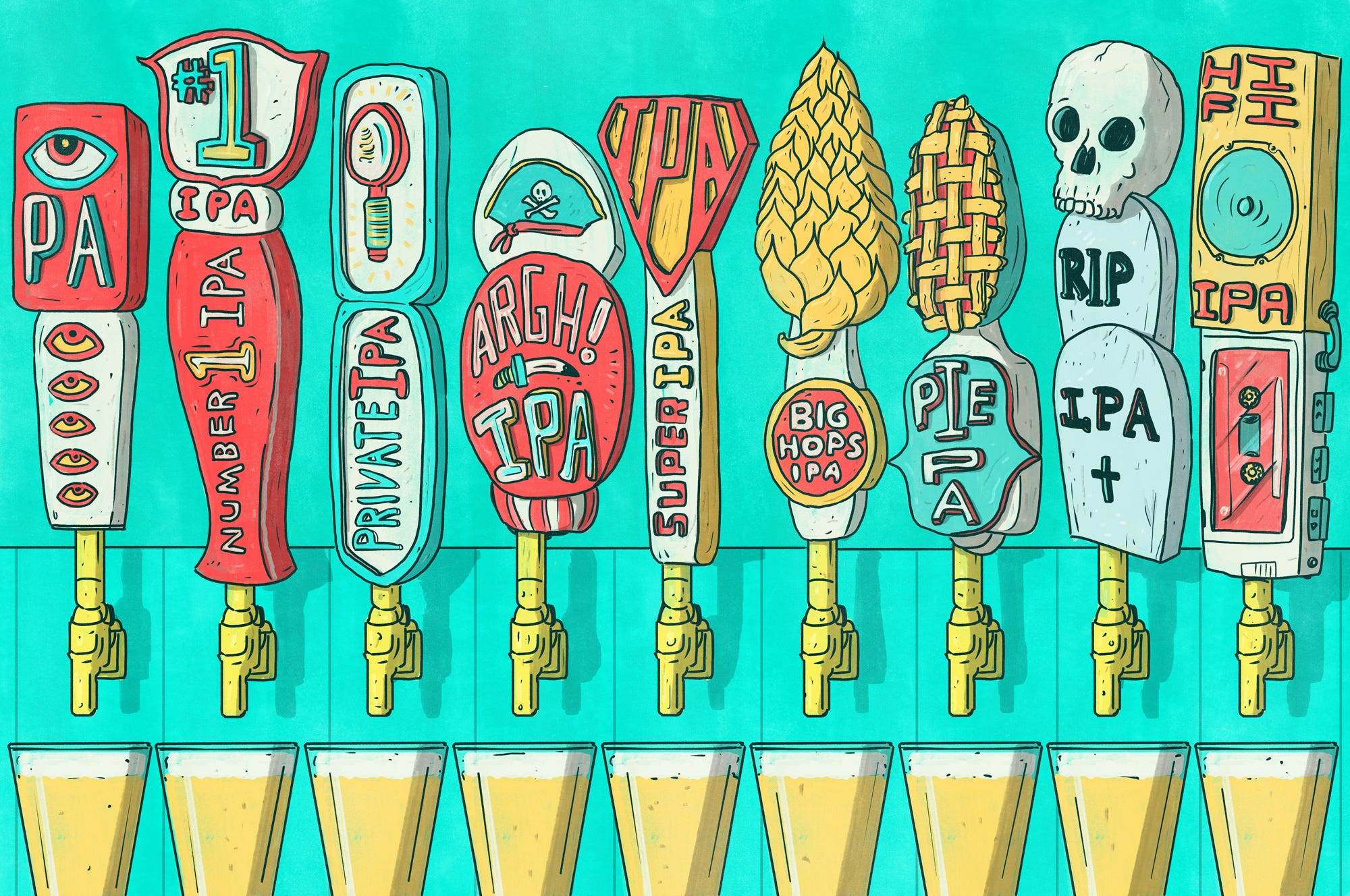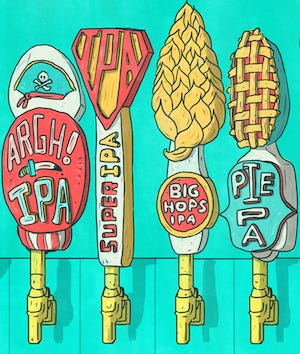
Recently, at a friend’s BYOB birthday party, I headed to the cooler to grab a drink and discovered only one type of beer: India Pale Ale. No, not one brand of beer — there were at least seven (I counted) different breweries represented. It’s just that they were all IPAs. I retreated to the refrigerator, where the beers that couldn’t fit in the cooler rested, to discover more of the same.
To a beer aficionado, it was kind of like opening a chocolate box and finding only marzipan. I wondered, what is happening here? Have we forgotten that there are other types of beer?
When I mentioned this to another partygoer, a recent college graduate, she nodded knowingly. “I started drinking beer when I was in college,” she said. “And at first, I honestly didn’t know that there were beers other than IPAs. That was just all people ever bought or drank.”
If young people nowadays think “IPA” when they hear “beer” — like how old people think “sandals” when they hear “thong” — you have to wonder if we’ve hit some cultural shift in the American beer palate. In the Year of the Monkey, and the 16th year of the Willennium, we may also be in the middle of an IPA moment, in which the most “normal” American beer has shifted from bland lagers to peppery, spicy IPAs.

How did we get to this milestone? Pause for some background for the non-beer nerds: IPA, an initialism for India Pale Ale, was supposedly invented by British colonists interested in producing beer that would survive the journey to India in the days before refrigeration. By adding a shit-ton of hops, a plant whose cone-like flowers are a primary constituent of beer, the colonists were able to produce an ale that didn’t spoil in the heat, taking advantage of the hops’ preservative traits. Moreover, the ale was so spicy that it didn’t really taste that different whether it was ice cold or lukewarm.
Prior to the craft-beer revolution in the United States, the American palate was accustomed to watery German lagers made by big brands (e.g., Budweiser, Coors, Keystone). As craft beers grew in popularity, some brewers started experimenting with the IPA style, notably California breweries Stone and Lagunitas — whose IPAs were industry defining.
“I know many brewers will make an IPA to serve as their cash cow,” said Saul Alpert-Abrams, cofounder of Solarc Brewing in Los Angeles. “The fact that they’re so incredibly popular is considered a fact in the industry.”
Yet American IPAs likely bear little resemblance to their British ancestors, mainly because of one more innovation: dry hopping. Dry hopping has been around as a practice for a long time but became very popular in the United States among craft brewers in the late 20th century. In short, dry hopping involves adding compressed hops pellets or whole cone flowers later in the process of brewing; rather than exclusively boiling the hops in the wort — the pre-fermented mix of ingredients that later becomes beer — the brewer adds yet more hops later in the process after the wort has cooled. Since in the process of dry hopping the hops are added after the wort is done boiling, it leaves in some of the volatile oils that would normally evaporate, resulting in the signature aromatic, fragrant, spicy flavor that most people associate with IPAs.
The phenomenon of IPAs becoming a mainstream beer was very recent and seems to have happened only during the past five years. According to CNBC, IPA sales shot up by 50% in 2014 compared to the previous year. During the same span, craft-beer sales overall rose by only 20%. “I know many brewers will make an IPA to serve as their cash cow,” said Saul Alpert-Abrams, cofounder of Solarc Brewing in Los Angeles. “The fact that they’re so incredibly popular is considered a fact in the industry.”
It turns out that IPAs’ increasing popularity might be because the hop oils are messing with our taste buds.
I spoke with Jake, an employee at craft brewery Grape & Grain in San Mateo, who told me the trend was glaring at his establishment. “I would love to have a draft list of eight sours, but it’s not what people want right now,” he told me. “They want IPAs.” To capitalize on the IPA trend, many breweries have started expanding the definition for marketing purposes, Jake explained. “Some beers will rebrand non-IPAs as IPAs — for instance, a red ale might now be called a red IPA.”

It turns out that IPAs’ increasing popularity might be because the hop oils are messing with our taste buds. There’s a slightly sensationalist theory that a parasite that lives in cats might be causing behavior changes in humans that make them love their cats even more; in the same vein, some have suggested that IPAs change our taste buds, making us crave evermore hops. The theory, called lupulin threshold shift (LTS) — lupulin being one of the bitter oils in the hops plant — suggests that those who taste something slightly hoppy will adapt to it and need to taste more hops oils over time to achieve the same effect. As John Moorhead from the American Homebrewers Association writes,
Andreas Keller and colleagues at Rockefeller University discovered that the perceived smell of an odor at a given concentration changes over time and depends on prior experience. In other words, the more you’re subjected to a smell, the more you adapt to it, thereby raising the threshold of that smell. Although this does not completely apply to nonvolatile bitter components, it has been shown that the brain, smelling hoppy aromas, expects a more bitter drinking sensation, or a lupulin threshold shift.
Sam Calagione, founder of Dogfish Head Brewery — whose “Hoo Lawd” beer was one of the hoppiest ever produced — once lamented that the big American corporate breweries’ bland lagers had been “hammered down people’s throats.” “I mean, banana cream pie may be your favorite fucking food,” Calagione said to a New Yorker reporter in 2008. “But if you ate banana cream pie every day you would hate it too.” Ah, how the foamy tides have turned in eight years; now his brewery’s flagship product, the IPA, has been hammered thoroughly down our throats.
So have IPAs finally peaked in popularity? There’s anecdotal evidence that the fad might be passing. Alpert-Abrams’s Solarc Brewing doesn’t even make hoppy beers like IPAs; instead, they specialize in gruits, a type of beer made with no hops that instead uses spices, vegetables and other ingredients for its flavors. “It’s kind of the anti-IPA,” Alpert-Abrams said. “It’s what we’re known for. And they’ve been selling really well for us.”

Are you a hops-head who can’t get enough IPA? Throw down in the comments below.







